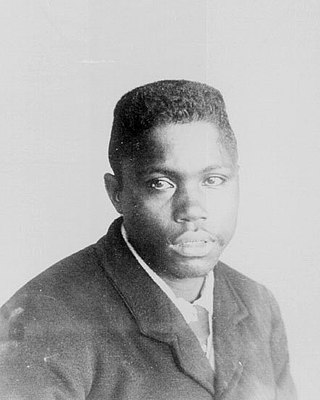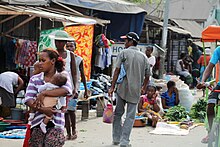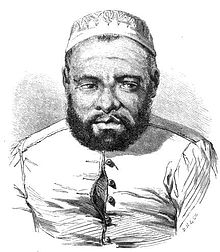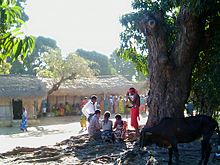
The history of Madagascar is distinguished clearly by the early isolation of the landmass from the ancient supercontinent of Pangaea, containing amongst others the African continent and the Indian subcontinent, and by the island's late colonization by human settlers from the Sunda islands and from East Africa. These two factors facilitated the evolution and survival of thousands of endemic plant and animal species, some of which have gone extinct or are currently threatened with extinction. Trade in the Indian Ocean at the time of first colonization of Madagascar was dominated by Indonesian ships, probably of Borobudur ship and K'un-lun po types.

The Toamasina Province is a former province of Madagascar with an area of 71,911 km². It had a population of 2,855,600 (2004). Its capital was Toamasina, the most important seaport of the country. The province was also known as Tamatave Province.

The Merina people are the largest ethnic group in Madagascar. They are the "highlander" Malagasy ethnic group of the African island and one of the country's eighteen official ethnic groups. Their origins are mixed, predominantly with Austronesians arriving before the 5th century AD, then many centuries later with mostly Bantu Africans, but also some other ethnic groups. They speak the Merina dialect of the official Malagasy language of Madagascar.

Andrianampoinimerina (1745–1810) ruled the Kingdom of Imerina on Madagascar from 1787 until his death. His reign was marked by the reunification of Imerina following 77 years of civil war, and the subsequent expansion of his kingdom into neighboring territories, thereby initiating the unification of Madagascar under Merina rule. Andrianampoinimerina is a cultural hero and holds near mythic status among the Merina people, and is considered one of the greatest military and political leaders in the history of Madagascar.

The Malagasy are a group of Austronesian-speaking ethnic groups indigenous to the island country of Madagascar. Traditionally, the population have been divided into ethnic groups. Examples include "Highlander" groups such as the Merina and Betsileo of the central highlands around Antananarivo, Alaotra (Ambatondrazaka) and Fianarantsoa, and the "coastal dwellers" such as the Sakalava, Bara, Vezo, Betsimisaraka, Mahafaly, etc.

The Tsimihety are a Malagasy ethnic group who are found in the north-central region of Madagascar. Their name means "those who never cut their hair", a behavior likely linked to their independence from Sakalava kingdom, located to their west, where cutting hair at the time of mourning was expected. They are found in mountainous part of the island. They are one of the largest Malagasy ethnic groups and their population estimates range between 700,000 and over 1.2 million. This estimation places them as the fourth-largest ethnicity in Madagascar.

Menabe is a region in western Madagascar, with its capital at Morondava. It covers an area of 46,121 square kilometres, and its population was 700,577 in 2018. The population mostly belongs to the Sakalava ethnic group. The region is named after the 18th-century Sakalava Kingdom of Menabe. The name "Menabe", in turn, means "big red", after the color of laterite rock that dominates the landscape.

Andriana was both the noble class and a title of nobility in Madagascar. Historically, many Malagasy ethnic groups lived in highly stratified caste-based social orders in which the andriana were the highest strata. They were above the Hova and Andevo (slaves). The Andriana and the Hova were a part of Fotsy, while the Andevo were Mainty in local terminology.

The KingdomofMerina, or Kingdom of Madagascar, officially the Kingdom of Imerina, was a pre-colonial state off the coast of Southeast Africa that, by the 18th century, dominated most of what is now Madagascar. It spread outward from Imerina, the Central Highlands region primarily inhabited by the Merina ethnic group with a spiritual capital at Ambohimanga and a political capital 24 km (15 mi) west at Antananarivo, currently the seat of government for the modern state of Madagascar. The Merina kings and queens who ruled over greater Madagascar in the 19th century were the descendants of a long line of hereditary Merina royalty originating with Andriamanelo, who is traditionally credited with founding Imerina in 1540.

The Betsimisaraka are the second largest ethnic group in Madagascar after the Merina and make up approximately fifteen percent of the Malagasy people. They occupy a large stretch of the eastern coastal region of Madagascar, from Mananjary in the south to Antalaha in the north. The Betsimisaraka have a long history of extensive interaction with European seafarers, pirates and bourgeois traders, which produced a significant subset with mixed European-Malagasy origins, termed the zana-malata. European influence is evident in the local valse (waltz) and basesa musical genres, which are typically performed on the accordion. Tromba ceremonies feature strongly in Betsimisaraka culture.

Malagasy is an Austronesian language and dialect continuum spoken in Madagascar. The standard variety, called Official Malagasy, is an official language of Madagascar alongside French.

The Antesaka, also known as Tesaka, or Tesaki, are an ethnic group of Madagascar traditionally concentrated south of Farafangana along the south-eastern coast. They have since spread more widely throughout the island. The Antesaka form about 5% of the population of Madagascar. They have mixed African, Arab and Malayo-Indonesian ancestry, like the western coastal Sakalava people of Madagascar from whom the clan derives. They traditionally have strong marriage taboos and complex funeral rites. The Antesaka typically cultivate coffee, bananas and rice, and those along the coast engage in fishing. A large portion of the population has emigrated to other parts of the island for work, with an estimated 40% of emigrants between 1948 and 1958 permanently settling outside the Antesaka homeland.

The Bara people are a Malagasy ethnic group living in the southern part of the central plateaus of Madagascar, in the Toliara Province, concentrated around their historic capital at Ihosy. The Bara are the largest of the island's zebu-herding peoples and have historically lived a semi-nomadic lifestyle, although an increasing proportion are practicing agriculture. Bara society is highly patriarchal and endogamy and polygamy are practiced among some Bara tribes. Young men practice cattle rustling to prove their manhood before marriage, and the kilalaky musical and dance tradition associated with cattle rustlers has gained popularity across the island.

The Antankarana are an ethnic group of Madagascar inhabiting the northern tip of Madagascar, around Antsiranana. Their name means "the people of the tsingy," the limestone rock formations that distinguish their traditional territory. The tsingy of the Antankarana may be visited at the Ankarana Reserve. There are over 50,000 Antakarana in Madagascar as of 2013.

The Bezanozano are believed to be one of the earliest Malagasy ethnic groups to establish themselves in Madagascar, where they inhabit an inland area between the Betsimisaraka lowlands and the Merina highlands. They are associated with the vazimba, the earliest inhabitants of Madagascar, and the many vazimba tombs throughout Bezanozano territory are sites of pilgrimage, ritual and sacrifice, although the Bezanozano believe the descendants among them of these most ancient of ancestors cannot be identified or known. Their name means "those of many small plaits" in reference to their traditional hairstyle, and like the Merina they practice the famadihana reburial ceremony. There were around 100,000 Bezanozano living in Madagascar in 2013.

The Makoa are an ethnic group in Madagascar descended from enslaved people from mainland Africa that were traded through the major slave trading ports of northern Mozambique in an area mainly populated by the Makua people. They are among the last African diaspora communities in the world to issue from the slave trade. They are sometimes classified as a subgroup of the fishing peoples known as the Vezo, although the Makoa maintain a distinct identity, one reinforced by their larger physical stature and historic employment as police officers by the French colonial administration.

The Sihanaka are a Malagasy ethnic group concentrated around Lake Alaotra and the town of Ambatondrazaka in central northeastern Madagascar. Their name means the "people of the swamps" in reference to the marshlands around Lake Alaotra that they inhabit. While rice has long been the principal crop of the region, by the 17th century, the Sihanaka had also become wealthy traders in slaves and other goods, capitalizing on their position on the main trade route between the capital of the neighboring Kingdom of Imerina at Antananarivo and the eastern port of Toamasina. At the turn of the 19th century they came under the control of the Boina Kingdom before submitting to Imerina, which went on to rule over the majority of Madagascar. Today the Sihanaka practice intensive agriculture and rice yields are higher in this region than elsewhere, placing strain on the many unique plant and animal species that depend on the Lake Alaotra ecosystem for survival.

The Hova, or free commoners, were one of the three principal historical castes in the Merina Kingdom of Madagascar, alongside the Andriana (nobles) and Andevo (slaves). The term hova originally applied to all members of a Malagasy clan that migrated into the central highlands from the southeast coast of the island around the 15th century and absorbed the existing population of Vazimba. Andriamanelo (1540–1575) consolidated the power of the Hova when he united many of the Hova chiefdoms around Antananarivo under his rule. The term Hova remained in use through the 20th century, though some foreigners transliterated that word to be Ankova, and increasingly used since the 19th century.

Binao (1867–1927) was a queen of the Sakalava people of Madagascar between 1881–1927. She was the granddaughter of King Andriantsoly of the Boina Kingdom, and acceded in 1881 to the throne of the Bemihisatra group of the Sakalava following the death of her mother, Safy Mozongo. She controlled a relatively small territory on the north-western coast of Madagascar consisting of the island of Nosy Be and a stretch of the mainland coast opposite. During the early years of her reign she faced the challenge posed by the ambitions of the mainland's dominant power, the Merina Kingdom.

The Andevo, or slaves, were one of the three principal historical castes among the Merina people of Madagascar, alongside the social strata called the Andriana (nobles) and Hova. The Andevo, along with the other social strata, have also historically existed in other large Malagasy ethnic groups such as the Betsileo people.

























